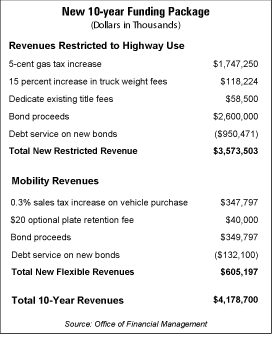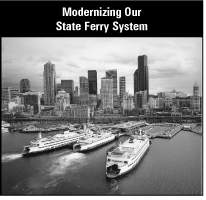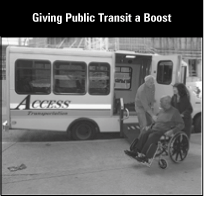
| “This transportation plan will accelerate economic recovery and create thousands of family-wage jobs.” Governor Gary Locke |
FOR TOO MANY YEARS, Washington's congested transportation system has cost commuters and businesses lost time and money getting to work and getting products to market. At last, help is on the way. The new transportation funding plan signed into law by Governor Gary Locke gives the state the tools to begin fixing and expanding our state's worn and crowded transportation system. The time to put Washington on the road to a brighter economic future has arrived.
A strong economy depends on good transportation
A good transportation system is the backbone of a vibrant economy. Washington businesses rely on roads, ports and rail lines to move their products to markets here and abroad. The transportation projects approved by the Legislature and Governor pave the way for economic development in rural and urban areas, cut congestion, improve safety, increase freight mobility and help Washington employers be more competitive.
At the same time, building a better transportation system - pouring the concrete and expanding mass transit - supports thousands of family-wage jobs at a time when Washington badly needs them.
New funding for transportation over 10 years
Governor Locke fought hard for the bipartisan solution that is strengthening the transportation backbone of Washington's economy. The legislation he signed authorizes spending nearly $4.2 billion over 10 years to build and expand highway lanes and interchanges, make highways safer, get freight to market more quickly and provide commuters transit, rail and other alternatives to driving. The funding package includes:
- $3.4 billion for highway and road projects.
- $605 million to provide alternatives to driving alone including investments in transit, vanpools, passenger rail, and new ferry terminals that will have better connections to transit, commuter rail, and other transportation services.
- $100 million to preserve existing vessels and terminals and to complete acquisition of four new auto ferries.
What motorists and businesses get
For motorists, the package adds 269 new lane-miles and 36 new or improved highway interchanges. New high occupancy vehicle (HOV) lanes are part of 16 new construction projects. For state ferry users, replacement of four auto ferries built in 1927 can be completed and commuters will use improved multimodal ferry terminals at Mukilteo, Anacortes and Edmonds. Track improvements statewide will ease the movement of freight, increase the speed of passenger rail trains and allow for additional state-sponsored Amtrak Cascades service. Investments are made in public transit in rural and urban areas, in commute trip reduction efforts and in vanpools.
Projects were chosen to ensure that each investment maximizes benefits to citizens. There won't be any “roads to nowhere.” The selection process relied on criteria that focused on direct benefits to the traveling public and the economy.
Each project is accountable to taxpayers
 Each project in the 10-year plan, and each project manager, is accountable to taxpayers. Citizens and their representatives now have the tools to measure how well the Department of Transportation carries out its responsibilities.
Each project in the 10-year plan, and each project manager, is accountable to taxpayers. Citizens and their representatives now have the tools to measure how well the Department of Transportation carries out its responsibilities.
The package ties specific funding to specific projects, holding the Department of Transportation to cost estimates and timelines. The new revenue for new projects is kept separate to ensure that it is dedicated only to identified projects.
Accountability and efficiency measures are built into the package with regular performance audits, improved project planning, streamlined permitting and specific contracting out provisions.
Congestion relief is key
The 10-year transportation plan invests $2.1 billion in the Central Puget Sound road system to improve I-405, and add HOV lanes on I-5, SR 167, SR 16, and other roadways. It adds lanes to SR 522 in Snohomish County, SR 161 and SR 410 in Pierce County, and SR 161, SR 520 and SR 900 in King County.
In addition, it adds $927 million in construction projects statewide so traffic can move more freely on highways like I-5 in Vancouver, I-90 in Spokane, SR 240 in the Tri-Cities, I-5 in Thurston and Lewis counties, SR 539 and SR 543 near the Canadian border in Whatcom County, US 12 between the Tri-Cities and Walla Walla, and the North Spokane Corridor in Spokane.
Investing in highway safety
 The plan provides $211 million to make highways safer. It clears the way for the eventual replacement of the Alaskan Way Viaduct, fixes “killer highways” like SR 270 in Pullman, replaces dangerous intersections, widens two-lane roads, straightens dangerous curves, builds left-turn lanes, improves dangerous bridges, installs traffic signals and installs median barriers to prevent cars from crossing the center line.
The plan provides $211 million to make highways safer. It clears the way for the eventual replacement of the Alaskan Way Viaduct, fixes “killer highways” like SR 270 in Pullman, replaces dangerous intersections, widens two-lane roads, straightens dangerous curves, builds left-turn lanes, improves dangerous bridges, installs traffic signals and installs median barriers to prevent cars from crossing the center line.
Preservation is a high priority
This package adds $134 million to current revenue, providing a 10-year investment of $2.7 billion to replace crumbling concrete road surfaces, repair bridges in danger of collapse during earthquakes, replace the eastern half of the Hood Canal Bridge, repair the Yakima River Bridge in Richland on SR 240 and make other major investments to ensure that existing facilities are well maintained.
Modernizing the state ferry system
Modernizing the state ferry system is essential. The transportation plan provides $298 million to complete the replacement of four auto ferries built in 1927 and improve ferry terminals at Edmonds, Mukilteo and Anacortes - linking ferry service with public transit and rail services.
Working on the railroad
The transportation plan invests $183 million in the passenger rail system, providing critical track improvements between Bellingham and Vancouver, WA. The funding also includes the cost of an additional train that will operate between Seattle and Portland.
A $45 million investment in freight rail will spur economic development by improving the movement of goods throughout the state and to Washington's ports. Moving more freight by rail means fewer trucks on our highways.
Public transit gets a boost, too
 Local transit service for the elderly and persons with disabilities gets help from nearly $100 million provided to both rural and urban areas. Additional investments also are made to improve transit service in rural areas of the state, and to fund a Seattle street car to serve South Lake Union.
Local transit service for the elderly and persons with disabilities gets help from nearly $100 million provided to both rural and urban areas. Additional investments also are made to improve transit service in rural areas of the state, and to fund a Seattle street car to serve South Lake Union.
Programs that reduce the number of cars on highways during morning and evening commutes, and which give urban commuters more transportation options, are supported by $60 million of investments including:
- $30 million to continue efforts to reduce the number of single-occupant vehicle trips through tax incentives to businesses and grants to other employers that encourage their employees to share rides to work.
- $30 million to improve vanpool options for urban commuters.
Total Investment: $4.2 billion
New cash revenue plus bond proceeds financed by the new transportation revenue sources provide an additional $4.2 billion for transportation projects over the next 10 years.
The Funding Package Includes:
- $3.4 billion for highway and road projects.
- $605 million to provide alternatives to driving alone, and new ferry terminals that will have better connections to transit, commuter rail, and other transportation services.
- $100 million to preserve existing vessels and terminals and to complete acquisition of four new auto ferries.
Project Selection Criteria:
- Provide congestion relief on highways
- Improve safety
- Improve the economy
- Improve public transit
- Speed the delivery of freight to markets
- Protect water quality and habitat
- Take advantage of funding partnerships
Investing in Congestion Relief:
- Includes $927 million in statewide construction projects
- Improves 405
- Adds HOV lanes on I-5, SR 167, SR 16 and other roadways
- Adds additional lanes on SR 522, SR 161, SR 410, SR 520, and SR 900
STAFF CONTACT:
Andrew Johnsen, Governor's Executive Policy Office
Phone: (360) 902-0643
Fax: (360) 586-8380
Email: [email protected]
Home
Governor Locke
- About the Governor
- Cabinet
- Senior Staff
- Executive Orders
- Proclamations
- Boards and Commissions
- Contact the Governor
The First Lady
News Room
About Washington
- Washington State Facts
- Photo Gallery
- The 50 State QuartersTM Program
- State Legislature
- Washington Courts
- US Census 2000
- Register to Vote